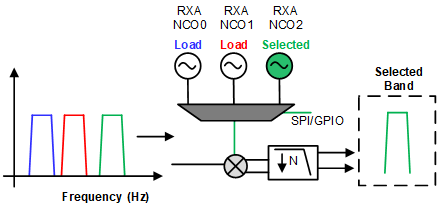SLAA870 February 2019 AFE7422 , AFE7444
-
Evaluating the frequency hopping capability of the AFE74xx
- Trademarks
- 1 Introduction
- 2 Phase Coherency vs Phase Continuity
- 3 AFE74xx Architecture
- 4 Frequency Hopping Methods
- 5 NCO Frequency Resolution Versus Hop Time
- 6 Fast Frequency Hopping With the Load and Switch
- 7 Register Addresses
- 8 References
6 Fast Frequency Hopping With the Load and Switch
Faster frequency hopping can be achieved when multiple frequency-flexible NCOs are available, as opposed to reprogramming one NCO.
When multiple NCOs are available, program the NCOs that are not selected to different frequencies in the background using the SPI while the currently selected NCO is active. When ready to change frequencies, change the selected NCO.
Figure 27 gives an example of this method using TI’s AFE74xx. In the AFE74xx each receiver (Rx) contains four available NCOs in dual-band mode, and three available NCOs in single-band mode. NCOs RXNCO0 and RXNCO1 respectively load the center frequencies of the blue and red bands in the input spectrum, while RXNCO2 is currently selected to downconvert the green band in the input spectrum. Thus, in order to hop to a different color band, send a command to select an NCO already programmed to the desired band frequency, greatly reducing hop time. Much less time is required to change NCOs than to reprogram a single NCO.
 Figure 27. Example of Frequency Hopping With Multiple NCOs
Figure 27. Example of Frequency Hopping With Multiple NCOs